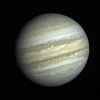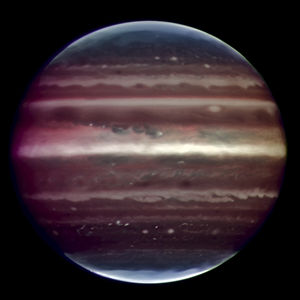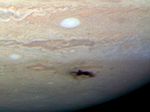- Portal:Jupiter
-
The Jupiter Portal
Jove
- Wikipedia portals:
- Culture
- Geography
- Health
- History
- Mathematics
- Natural sciences
- People
- Philosophy
- Religion
- Society
- Technology
Jupiter is the fifth planet from the Sun and the largest planet within the Solar System. It is a gas giant with a mass slightly less than one-thousandth of the Sun but is two and a half times the mass of all the other planets in our Solar System combined. Jupiter is classified as a gas giant along with Saturn, Uranus and Neptune. Together, these four planets are sometimes referred to as the Jovian or outer planets. The planet was known by astronomers of ancient times and was associated with the mythology and religious beliefs of many cultures. The Romans named the planet after the Roman god Jupiter. When viewed from Earth, Jupiter can reach an apparent magnitude of −2.94, making it on average the third-brightest object in the night sky after the Moon and Venus. (Mars can briefly match Jupiter's brightness at certain points in its orbit.)
Jupiter is primarily composed of hydrogen with a quarter of its mass being helium; it may also have a rocky core of heavier elements. Because of its rapid rotation, Jupiter's shape is that of an oblate spheroid (it possesses a slight but noticeable bulge around the equator). The outer atmosphere is visibly segregated into several bands at different latitudes, resulting in turbulence and storms along their interacting boundaries. A prominent result is the Great Red Spot, a giant storm that is known to have existed since at least the 17th century when it was first seen by telescope. Surrounding the planet is a faint planetary ring system and a powerful magnetosphere. There are also at least 63 moons, including the four large moons called the Galilean moons that were first discovered by Galileo Galilei in 1610. Ganymede, the largest of these moons, has a diameter greater than that of the planet Mercury. Jupiter has been explored on several occasions by robotic spacecraft, most notably during the early Pioneer and Voyager flyby missions and later by the Galileo orbiter. The most recent probe to visit Jupiter was the Pluto-bound New Horizons spacecraft in late February 2007. The probe used the gravity from Jupiter to increase its speed. Future targets for exploration in the Jovian system include the possible ice-covered liquid ocean on the moon Europa.
Selected article
Adrastea (pronounced /ˌædrəˈstiːə/ ad-rə-stee-ə, or as in Greek Αδράστεια), also known as Jupiter XV, is the second by distance, and the smallest of the four inner moons of Jupiter. It was discovered in Voyager 2 probe photographs taken in 1979, making it the first natural satellite to be discovered from images taken by an interplanetary spacecraft, rather than through telescopic photography.It was officially named after the mythological Adrastea, foster mother of Greek god Zeus—the equivalent of Roman god Jupiter. Adrastea is one of the few moons in the Solar System known to orbit its planet in less than the length of that planet's day. It orbits at the edge of Jupiter's Main Ring and is thought to be the main contributor of material to the Rings of Jupiter. Despite observations made in the 1990s by the Galileo spacecraft, very little is known about the moon's physical characteristics outside its size and the fact that it is tidally locked to Jupiter.Selected biography
Immanuel Velikovsky (Иммануил Великовский) (Vitebsk, 10 June 1895 (NS) – 17 November 1979) was a Russian-born American independent scholar, best known as the author of a number of controversial books reinterpreting the events of ancient history, in particular the US bestseller Worlds in Collision, published in 1950. Earlier, he played a role in the founding of the Hebrew University of Jerusalem in Israel, and was a respected psychiatrist and psychoanalyst.Topics
Jupiter Atmosphere ˑ Exploration (Voyager 2) ˑ Rings
Astronomers: Galileo Galilei ˑ Gan De ˑ Gerard Kuiper ˑ Giovanni Domenico Cassini
See Also: Formation and evolution of the Solar System ˑ Gas Giant ˑ Nebular hypothesis
Bold articles are featured.
Italicized articles are on dwarf planets or minor moons.Selected picture
Jupiter shows a new mood with a modern infrared false-color photograph.
Related portals
In the news
Wikinews Space portal- September 10: Out of space in outer space: Special report on NASA's 'space junk' plans
- August 18: SETI Institute set to re-open
- August 9: DNA components found in meteorites
- August 6: Juno spacecraft bound for Jupiter
- July 22: Space Shuttle Atlantis landing concludes program
- July 8: End of an era: Space Shuttle Atlantis launches on final mission in program
- July 8: Cassini spacecraft captures large storm on Saturn
- July 1: U.S. space agency NASA sues ex-astronaut
- June 29: Debris narrowly misses International Space Station
- June 23: Saturn moon Enceladus may have salty ocean
- June 17: Study says young stars 'shoot water bullets'
- June 4: Space Shuttle Endeavour enters history books after nineteen years following penultimate landing of program
Things to do
Contribute to...
- ...articles on Jupiter to help make them featured articles.
Expand...
- ...astronomy stubs.
Join...
- ...WikiProjects related to this subject.
WikiProject Solar System requests

Here are some tasks you can do:- Article requests:
- To help us assess the quality and importance of Solar System articles, please see: Category:Unassessed Solar System articles and Category:Unknown-importance Solar System articles.
- Stubs: Beagle (crater), Early bombardment phase, Kordylewski cloud, List of Solar System bodies formerly regarded as planets, Small Solar System body, Solar conjunction
Categories:- Jupiter portal
- Taskforce Jupiter
- Jupiter
- Astronomy portals
- WikiProject Solar System
Wikimedia Foundation. 2010.
















